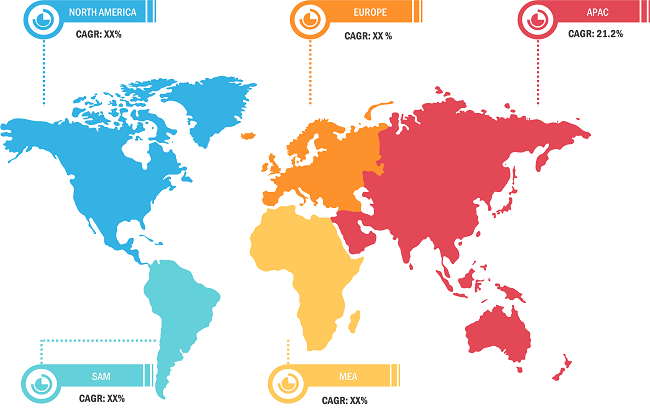The global GPU Database market size is expected to reach US$ 1,112.11 million by 2028, registering at a CAGR of 19.1% from 2022 to 2028, according to a new research study conducted by The Insight Partners.
Rising Number of Cyberattacks Boosts Demand for GPU Database Market
People are generating more real-time data due to globalization and digital transformation in the tech-driven era. As per FinancesOnline, an independent platform for B2B, SaaS, and financial solutions, quoted 50,000 messages and 147,000 images are sent and received on Facebook daily. Also, Instagram users post around 347,222 stories every day. 1,388,889 voice calls and messages are sent out daily. Netflix users stream 404,444 hours of video content every day. Thus, with such a rise in data daily through social media, video sharing, and communications, the need for a GPU database to handle a large amount of data emerges. The increase in internet users and the rise in the number of search queries are also increasing the data volume at large scale across various industries. Thus, such an increase in data generation from multiple industries is escalating the need for supercomputers wherein GPUs are used, which is boosting GPU database market growth. As per the Data Reportal, as of January 2022, 4.95 billion people were using social platforms, which is about 62.5% of the world population. According to the statistics from stat counter, Google is dominating the market, being number one search engine, with a 91.42% market share in 2021. As per expert predictions, in January 2022, google processed about 1.2 trillion searches in 2021, which equates to 6 billion searches a day. Thus, such an increase in data generation on various digital platforms in the BFSI, media, and entertainment sectors is fueling the demand for GPU databases and driving the GPU database market share in the global economy.
Based on the GPU database market report, the GPU database market is segmented based on component, deployment, application, and industry vertical, and geography. Based on components, the GPU database market is bifurcated into Tool and Services. In terms of deployment, the GPU database market is segmented into on-premises and cloud-based. Based on application, the GPU database market is segmented into fraud detection & prevention, governance risk & compliance (GRC), customer experience management, predictive maintenance, supply chain management, threat intelligence, and others. Based on industry vertical, the GPU database market is segmented into BFSI, IT & telecom, retail & e-commerce, healthcare, transportation & logistics, government & defense, and others. Based on geography, the GPU database market is segmented into North America (the US, Canada, and Mexico), Europe (Germany, France, Italy, UK, Russia, and Rest of Europe), and Asia Pacific (Australia, China, India, Japan, South Korea, and Rest of APAC), the Middle East & Africa (South Africa, Saudi Arabia, the UAE, and Rest of MEA), and South America and Central America ( Brazil, Argentina, and Rest of SAM).
GPU Database Market – by Region, 2021 and 2028 (%)

GPU Database market by Analysis by Size, Share Growth Report 2025
Download Free SampleGPU Database Market Size and Forecast (2021 - 2031), Global and Regional Share, Trend, and Growth Opportunity Analysis Report Coverage: By Component (Tool and Service), Deployment (Cloud Based and On-Premise), Application [Fraud Detection & Prevention, Governance Risk & Compliance (GRC), Customer Experience Management, Predictive Maintenance, Supply Chain Management, Threat Intelligence, and Others], Industrial Vertical (BFSI, IT & Telecom, Retail & E-Commerce, Healthcare, Transportation & Logistics, Government & Defense, and Others), and Geography
Source: The Insight Partners Analysis
Impact of COVID-19 Pandemic on GPU Database Market
The COVID-19 outbreak dramatically impacted the global economy during its peak in 2020 in its initial days. The pandemic hampered business activities in IT and business industries. The economic crisis after the pandemic caused a significant delay in the commercial roll-out of the next–generation technologies. Small and medium-scale companies are the backbone of technology providers and have witnessed a steep revenue drop since the pandemic in 2020. The covid-19 pandemic affected the value chain analysis and financially impacted certain companies. However, the COVID-19 outbreak positively influenced the GPU database market as it accelerated the adoption of artificial intelligence and machine learning across every vertical of the industry. The emergence of the pandemic compelled enterprises to rapidly move their critical workload to the cloud to ensure seamless business functions. The cloud is gaining momentum, and enterprises are working on optimizing their network, storage, and agility and achieving a higher bandwidth, wherein the GPU database has turned out to be the perfect solution. The emergence of advanced technologies such as the Internet of Things (IoT), Internet of Behaviors (IoB), artificial intelligence (AI), and machine learning (ML) is driving the demand for GPU databases, owing to the availability of higher bandwidth. The increase in IoT devices in the post-pandemic era and the rise in the need to train state-of-the-art models for regular use or research applications had influenced the GPU database market growth. Thus, owing to growing popularity of IoT devices, it is widely preferred to go for high-end GPUs such as RTX 8000, RTX 6000, and Titan RTX, which has augmented the GPU database industry growth.
BRYTLYT; GRAPHISTRY; H2O.ai; Jedox; Kinetica DB Inc; Neo4J, INC; SQream Technologies; ZILLIZ; NVIDIA CORPORATION; HEAVY.AI are among the leading players operating in the GPU database market.
The GPU database market report provides detailed GPU database market analysis to help key players strategize the GPU database industry growth in the coming years. It also forecasts the upcoming trends and developments in the GPU database market.
Contact Us
Phone: +1-646-491-9876
Email Id: sales@theinsightpartners.com